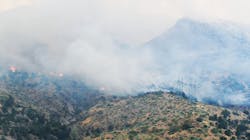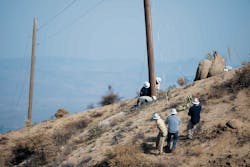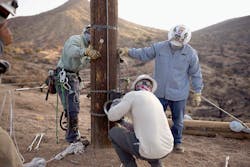Grid Reliability in the Face of Record Wildfires and Pandemic
While most know the West Coast experienced devastating wildfires in 2020, it also was one of the most treacherous wildfire seasons in Arizona, especially for power utilities. With more than 1600 fires and around 700,000 acres (283,280 hectares) burned, the 2020 wildfire season totaled more than Arizona’s 2018 and 2019 seasons combined. In fact, 2020 was Arizona’s hottest summer on record and third driest. These conditions, pooled with the safety precautions and implications associated with the COVID-19 pandemic, made electric system operations across the state challenging, to say the least.
For Salt River Project (SRP), the wildfires took a great toll, damaging the utility’s T&D and communications systems. Though the fire damage was some of the worst the organization had ever experienced, SRP found new ways to improve its operating procedures, incident command structure and general response to fires. If the unparalleled year taught SRP anything, it was to expect the unexpected and continue pushing forward.
Foundational Relationships
As part of its operating procedures, and for more than 18 years, SRP has been deploying a liaison to maintain situational awareness of wildfires that threaten the utility’s power system assets. Having someone there in the action, alongside fire management teams and state agencies, means the utility receives updates in real time. In more recent years, these updates have included detailed digital maps of fires as they progress and specifics on the fire management tactics underway.
SRP’s wildfire liaison coordinates the utility’s response with other utilities and agencies — including the U.S. Bureau of Land Management, Arizona State Land Department and U.S. Forest Service — local counties and municipalities to minimize the impact to power lines and other utility operations. In addition to ensuring fire crews know which assets are most critical to power operations and must be protected whenever and wherever possible, the liaison coordinates power line outages to enhance firefighter safety while minimizing impacts to SRP customers. Responsibilities of the liaison have expanded throughout the years, and the relationships garnered with agencies have become highly valuable.
The wildfire liaison also works with agency counterparts to gain access into wildfire areas otherwise closed off to the public. This was the case in 2020 with one particular fire, designated the Salt Fire, that infringed on a joint power corridor that houses 500-kV lines for SRP and another large Arizona utility. SRP specialists worked closely with agency personnel to monitor the fire’s path, which burned along SRP’s 500-kV corridor for more than 10 miles (16 km), causing the line to trip out of service multiple times as a result of smoke. Fire management teams gave clearance to SRP to conduct aerial inspections at various times throughout the fire response. Each inspection offered the utility valuable insights into ongoing risks for its 500-kV operations and damage to other lower-voltage lines in the area.
Constant Communication
The bulk of SRP’s past encounters with wildfires have affected one type of asset at a time: a transmission line here, a distribution line there. Correspondingly, SRP’s liaison managed these incidents directly with the departments responsible for the affected assets. This process worked well for a long time. However, more recently, larger fires closer to SRP’s service territory have simultaneously affected T&D, generation and other assets, making direct communication between SRP’s liaison in the field and individual departments an impossible task during a fluid event like a wildfire. In a circumstance like that, every impacted department needs a clear understanding of the situation at the same time.
Lessons learned from these impactful fire events has resulted in SRP implementing an incident command system (ICS), a communication structure that mirrors that of fire response crews. SRP’s updated ICS structure prioritizes steady com-munications between the team in the field and appointed individuals from all relevant operations and communications groups. In this structure, fire operational monitoring calls are scheduled as often as three times daily or more on days where multiple wildfires threaten the system. This has proved to be the most efficient way to make informed decisions on SRP’s overall response and priorities related to keeping customers in service and system reliability.
The ICS appoints decision makers, including a designated incident commander — which can change from event to event, as SRP has identified a number of team members who can serve in this role — and key players across the utility from distribution maintenance, transmission line maintenance, transmission and generation operations, telecommunications, media relations, T&D asset optimization, baseload generation and more. Importantly, members of the core incident command team may serve in a role that looks quite different from their typical day job.
For instance, during the Salt Fire, SRP assigned a restoration section chief to be responsible for coordinating the repair of all damaged T&D and communications assets. Normally, this individual is the director of distribution maintenance and responsible for the crews and design group that do maintenance work on the utility’s 12-kV system. He regularly responds to equipment failures and storm damage, but — unique to the restoration chief role — he also had responsibility for overseeing transmission crew work on the 115-kV system and was accountable to the communications group to restore damaged fiber-optic cable. Under usual circumstances, these facilities are managed by three independent organizations. By managing restoration in this way, SRP ensures any shared resources needed to address the incident are prioritized according to the greatest need.
In the instance of 500-kV line faults, the team used ICS touch-base calls during the Salt Fire event to discuss when to derate the line and worked hand in hand with the SRP communications team to send public notifications to customers. The notifications requested customers to reduce their energy use on the evening of the event. Even with a major line out of service, SRP did not have any rolling outages and leadership credited the success to the ICS coordination and constant communication between teams.
Resource Demand Meets Power Demand
There is no denying 2020 was an unprecedented year with unforeseen circumstances. The COVID-19 pandemic and record heat in Arizona resulted in community members working from home, consistently using air conditioning and putting more strain on SRP’s power grid than ever before. In July, SRP delivered a record retail peak demand of 7615 MW. That peak topped the utility’s previous system peak of 7305 MW in 2018. The utility also continued to serve near-record loads at a time when fires were disrupting parts of the transmission system and energy demands across the West were uncharacteristically high.
In addition to the hot summer, the winter prior was a wet one, which meant vegetation across the state had grown exponentially with grasses and other fast-growing brush covering the landscape. This excess mixed with record dry conditions in the summer and relatively no monsoon storms meant fires were starting easily all over the state and moving quickly.
There have been previous dry summers with conditions that resembled those in 2020, but, in a typical year, Arizona and other wildfire-prone states receive resources from around the U.S. to help manage fires in highly critical areas. This year, however, Arizona along with many other western states experienced record-setting fire seasons. With so many fires burning in the western U.S. at the same time, constraints on available firefighting resources were an added complication.
Having few fire teams available and huge demand on the grid meant there was little room for error across SRP’s system. The incident command team’s restoration chief was responsible for restoring T&D and communications assets damaged by the Salt Fire. At the same time, the rest of SRP had to keep a close watch on the undamaged assets and systems the utility was relying on to serve load while repairs from the fire took place.
SRP’s wildfire liaison educated fire crews wherever possible on which system assets were critical to operations and could not afford to lose power, such as transmission lines with direct paths to generation stations. The liaison also strived to safeguard fire crews from going near energized lines and assets, ensuring that part of firefighting operations never required any guesswork and unnecessary risk. Fire crews continually updated SRP specialists on when and where backburning operations would take place, which helped SRP to gain improved situational awareness on how the fire was being managed and when there was potential for stabilization. Backburning is the act of clearing certain areas by creating a new fire that burns in the opposite direction, burning down the fuel — or potential path — for the larger fire to travel.
Looking Ahead
SRP successfully served load during the summer of 2020 despite unusually high demand and wildfire disruptions. As Arizona heads into what is projected to be a dry winter season, SRP is looking for ways to strengthen and harden its system. This includes conducting thorough physical inspections of all lines and assets, managing potential threats like overgrown vegetation and continued emphasis on proactive maintenance.
Growing the utility’s relationships and improving situational awareness of evolving wildfire threats will remain top priorities in the coming years, as in 2020 they proved to be a saving grace in what was one of the most challenging circumstances southwestern utilities have ever experienced. SRP will continue to review its operating procedures and make improvements to them as well as its ICS structure to match lessons learned — even in the most unprecedented of wildfire seasons.
Zack Heim is director of transmission line design, construction and maintenance at SRP, where he has worked for more than 16 years. He received his BSCE and MSCE degrees from Arizona State University.
Chris Hofmann is director of transmission and generation operations at SRP. He received his BSEE degree with focus in distribution power systems and MBA degree in organizational behavior and project management from the University of Nevada, Reno.
Floyd Hardin is the fire management officer and construction consultant on transmission line asset management and maintenance at SRP. Floyd is a second-generation SRP employee and has been with the utility for 35 years. He received his master’s certification in infrastructure protection from Texas A&M Engineering Extension Service (TEEX).
About the Author
Zack Heim
Zack Heim is director of transmission line design, construction and maintenance at SRP, where he has worked for more than 16 years. He received his BSCE and MSCE degrees from Arizona State University.
Chris Hofmann
Chris Hoffman is director of transmission and generation operations at SRP. He received his BSEE degree with focus in distribution power systems and MBA degree in organizational behavior and project management from the University of Nevada, Reno.





